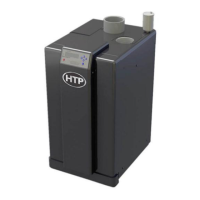LP-387 Rev. 011 Rel. 005 Date 1.3.19
46
Figure 35 - Gas Valve
Part 9 - Start-Up Preparation
C. Boiler Gas Valve
A. Check / Control Water Chemistry
Chemical imbalance of the water supply may aect eciency
and cause severe damage to the appliance and associated
equipment. It is important that the water chemistry on both the
domestic hot water and central heating sides are checked before
installing the appliance. Water quality must be professionally
analyzed to determine whether it is necessary to treat the water.
Various solutions are available to adjust water quality. Adverse
water quality will aect the reliability of the system. In addition,
operating temperatures above 135
o
F will accelerate the build-up
of lime scale and possibly shorten appliance service life. Failure of
an appliance due to lime scale build-up, low pH, or other chemical
imbalance IS NOT covered by the warranty.
To assure extended service life, it is recommended to test water
quality prior to installation. Listed below are some guidelines.
Do not use petroleum-based cleaning or sealing compounds in
the boiler system. Damage to elastomer seals and gaskets in the
system could occur, resulting in substantial property damage.
Closed loop water must be free of corrosive chemicals, sand, dirt,
and other contaminates. It is up to the installer to ensure the water
does not contain corrosive chemicals or elements that can damage
the heat exchanger.
If you suspect that your water is contaminated in any way,
Thoroughly clean and ush any system that has used glycol before
installing the boiler. Provide the customer with a material safety
data sheet (MSDS) on the uid used.
B. Check for Gas Leaks
Before starting the boiler, and during initial operation, smell near
the oor and around the boiler for gas odorant or any unusual odor.
Remove boiler front door and smell interior of boiler enclosure.
Do not proceed with startup if there is any indication of a gas leak.
Repair any leaks at once.
PROPANE BOILERS ONLY – The propane supplier mixes an odorant
with the propane to make its presence detectable. In some instances
the odorant can fade, and the gas may no longer have an odor.
Before startup (and periodically thereafter), have the propane
supplier verify the correct odorant level in the gas.
discontinue use of the appliance and contact an authorized technician
or licensed professional.
• Water pH between 6.5 and 8.5
• Hardness less than 7 grains (120 mg/L) (Water temperatures
of 140
o
F and greater)
• Chloride concentration less than 100 ppm (mg/L)
• Total Dissolved Solids (TDS) less than 500 ppm (mg/L)
*NOTE: It is recommended to clean the heat exchanger at least once
a year to prevent lime scale buildup. To clean the heat exchanger,
follow the maintenance procedure in this manual.
Clean system to remove sediment*
1. You must thoroughly ush the system (without boiler connected)
to remove sediment. The high-eciency heat exchanger can be
damaged by buildup or corrosion due to sediment.
2. For zoned systems, ush each zone separately through a purge
valve. (If purge valves and isolation valves are not already installed,
install them to properly clean the system.)
3. Flush system until water runs clean and you are sure piping is free
of sediment.
*NOTE: It is recommended you clean heat exchanger at least once a
year to prevent lime scale buildup. Follow the maintenance procedure
to clean the heat exchanger in the Maintenance Section of this manual.
Test/replace freeze protection uid
1. For systems using freeze protection uids, follow uid manufacturer’s
instructions to verify inhibitor level and that other uid characteristics
are satisfactory.
2. Freeze protection uid must be replaced periodically due to
degradation of inhibitors over time. Follow all uid manufacturer
instructions.
NOTE: Boiler failure due to improper water chemistry is not
covered by warranty.
C. Freeze Protection (When Used)
NEVER use automotive or standard glycol antifreeze. Do not use
ethylene glycol made for hydronic systems. Use only freeze-
protection uids certied by uid manufacturer as suitable for
use with stainless steel boilers, veried in the uid manufacturer’s
literature. Thoroughly clean and ush any system that has used
glycol before installing the new boiler. Provide the boiler owner with
a material safety data sheet (MSDS) on the uid used.
1. Determine the freeze protection uid quantity using total system
water content following the uid manufacturer’s instructions.
Remember to include expansion tank water content.
2. Local codes may require back ow preventer or actual disconnect
from city water supply.
3. When using freeze protection uid with automatic ll, install a
water meter to monitor water makeup. Freeze protection uid may
leak before the water begins to leak, causing concentration to drop,
reducing the freeze protection level.

